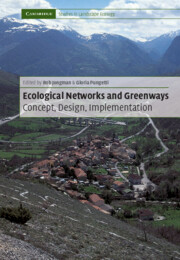Book contents
- Frontmatter
- Contents
- List of contributors
- Foreword
- Preface
- Acknowledgements
- 1 Introduction: ecological networks and greenways
- 2 The context and concept of ecological networks
- 3 Greenways in the USA: theory, trends and prospects
- 4 Ecological functioning of ecological networks: a species perspective
- 5 Impacts of roads on ecological networks and integration of conservation and transportation planning: Florida as a case study
- 6 Ecological corridors on a European scale: a typology and identification of target species
- 7 Planning the future landscape between nature and culture
- 8 From models to reality: design and implementation process
- 9 Design of the Pan-European Ecological Network: a national level attempt
- 10 Ecological ‘black spots’ within the ecological network: an improved design for rural road network amelioration
- 11 An ecological network for the Milan region based on focal species
- 12 Connecting corridors: implementing metropolitan greenway networks in North America
- 13 The Florida Statewide Greenways Project: its realisation and political context
- 14 The ecological network development in the Yungas, Argentina: planning, economic and social aspects
- 15 The river corridor of the Guadiamar
- 16 Conclusions: into the twenty-first century
- References
- Index
3 - Greenways in the USA: theory, trends and prospects
Published online by Cambridge University Press: 29 December 2009
- Frontmatter
- Contents
- List of contributors
- Foreword
- Preface
- Acknowledgements
- 1 Introduction: ecological networks and greenways
- 2 The context and concept of ecological networks
- 3 Greenways in the USA: theory, trends and prospects
- 4 Ecological functioning of ecological networks: a species perspective
- 5 Impacts of roads on ecological networks and integration of conservation and transportation planning: Florida as a case study
- 6 Ecological corridors on a European scale: a typology and identification of target species
- 7 Planning the future landscape between nature and culture
- 8 From models to reality: design and implementation process
- 9 Design of the Pan-European Ecological Network: a national level attempt
- 10 Ecological ‘black spots’ within the ecological network: an improved design for rural road network amelioration
- 11 An ecological network for the Milan region based on focal species
- 12 Connecting corridors: implementing metropolitan greenway networks in North America
- 13 The Florida Statewide Greenways Project: its realisation and political context
- 14 The ecological network development in the Yungas, Argentina: planning, economic and social aspects
- 15 The river corridor of the Guadiamar
- 16 Conclusions: into the twenty-first century
- References
- Index
Summary
Introduction
Development in Europe and the USA have common roots, but to a great extent they went their own way owing to geographical, political and scientific differences. Whereas ecological networks are common in Europe, greenways are much more an American product.
This chapter is organised to address several objectives:
to compare classic and emerging definitions of greenways
to articulate greenway theory, and to link definitions with theoretical principles
to review the origin and evolution of greenways in the USA
to discuss future prospects and research needs for greenways
Greenways is a ‘new’ word with many meanings. Much confusion still exists around its definition, yet it continues to gain in popularity and to appear regularly in popular language and planning policy in the USA and internationally (Fabos and Ahern 1995). The many differing perspectives on greenways are reflected in these definitions and serve to emphasise the complexity of the greenway concept. A brief review of these definitions provides a useful introduction to the subject of greenways, and underscores the need for a common definition and taxonomy, to support international, interdisciplinary communication and collaboration.
Perhaps the most widely accepted contemporary definition or statement on greenways in the USA was included in the report of the President's Commission on Americans Outdoors in the USA (1987). The Commission advocated a greenways network:
to provide people with access to open spaces close to where they live, and to link together the rural and urban spaces in the American landscape threading through cities and countrysides like a giant circulation system.
- Type
- Chapter
- Information
- Ecological Networks and GreenwaysConcept, Design, Implementation, pp. 34 - 55Publisher: Cambridge University PressPrint publication year: 2004
- 24
- Cited by



